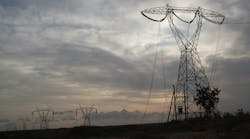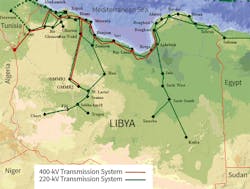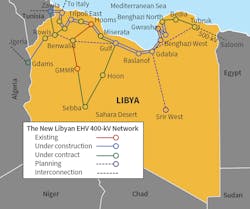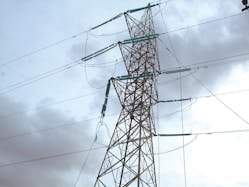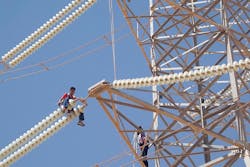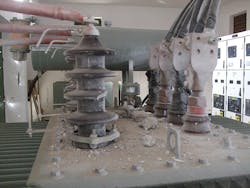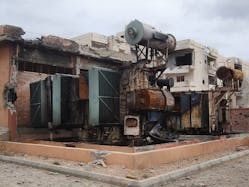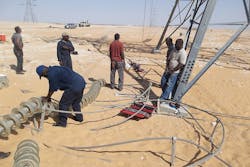Following a decade of electric power trading and wheeling up to 600 MW with neighboring countries, the unified Libyan transmission system has been split into four separate regional islands. The cross-border interconnections have been disconnected, which has led to extended blackouts in many parts of the country. The separation of the interconnected Libyan transmission system was a result of severe damage to many of the ultrahigh-voltage and high-voltage sections of the system during an ongoing civil war that followed the Arab Spring uprising.
Situated in the center of North Africa, Libya has a relatively small population and one of the longest coastlines on the Mediterranean Sea. Despite oil-gas plants and significant natural resources, one way in which the country is currently suffering is because of its electrically isolated regions. The Libyan transmission system used to be part of a grid that encircled the Mediterranean transmission system, which connects Arab and European countries. The Libyan system supplied and wheeled power to the neighboring countries of Tunisia and Egypt.
Because of Libya’s ongoing civil war, which began in July 2014, various events have caused damage to numerous 400-kV, 220-kV and 66-kV transmission lines and substations, resulting in the transmission system now operating as four islanded systems. The current separate transmission systems have reduced generation capacity in the most populated area in the northwest (Tripolitania), which now has an electricity demand that is higher than the installed generating capacity. Conversely, there is now excess generating capacity connected to the remaining three islanded transmission systems that supply the large cities of Benghazi, Adjdabia and Ghadams.
Transmission System Operator
The General Electric Company of Libya (GECOL), which operates under the newly formed Ministry of Electricity and Renewable Energy, is a government-owned electric utility responsible for operation of the entire power sector in Libya, from electricity generation to the end users. The four physically split islanded networks were built during the early stages of system development. Following unification in the early 1990s, the entire transmission system now serves around 1.8 million customers across the 1.76-million-sq-km (679,540-sq-mile) Libyan territory, which has a population of 6.2 million people.
The available installed generating capacity in the existing power plants totals 5500 MW. Prior to the 2011 Arab Spring uprising, two renewable projects were under construction: a 100-MW wind farm in the Green Mountain area in the eastern region and a 50-MW solar plant in the Magroun area in the middle of the country. These renewable projects have not been completed.
North African Interconnections
A geographically large state, Libya shares borders with six neighboring countries, four Arab states (Egypt, Sudan, Algeria and Tunisia) and two African states (Chad and Niger). Currently, Libya is only electrically interconnected with Egypt and Tunisia on its eastern and western borders, respectively. Since the circuits were first commissioned, more than 600 MW of energy has been exchanged commercially through the tie lines in each direction.
The 220-kV double-circuit interconnection with Egypt connects the Tobruk substation in Libya — approximately 165 km (103 miles) from the border — with the Salum substation in western Egypt, close to the city of Alamin. This transmission line extends across the Egyptian desert before reaching the areas of high-energy consumption and load centers, namely the Mediterranean city of Alexandria.
The transmission systems of GECOL and the Tunisian National Company of Electricity and Gas (STEG) are interconnected by two 220-kV transmission lines. The first cross-border link, known as the coastal line, is a double-circuit 220-kV transmission line that interconnects the Abukamash substation in Libya with the Madneen and Abushama substations in Tunisia. The overall length of this circuit is 380 km (236 miles), with 26 km (16 miles) in Libya and 354 km (220 miles) in Tunisia. The second 220-kV circuit, known as the Sahara line, is a single circuit connecting the Rouais substation in Libya with the Tataween substation in Tunisia. This circuit is 298 km (185 miles) long, with 37 km (23 miles) in Libya and 261 km (162 miles) in Tunisia.
Disconnected Grids
Prior to the uprising in February 2011, power trading with Egypt was unidirectional. The load transfer flowing to the Libyan grid was greater than the power exported to Egypt. This situation remained unchanged for almost six years until the civil war stemming from the Arab uprising began in February 2011. The damage caused by air raids to the high-voltage transmission line connecting the eastern and western grids resulted in excess generation capacity in the eastern sector and a shortage of generation in the western sector of the country.
As such, the load transfer flowing eastward to the Egyptian grid increased for a period of seven months, which reset the six-year pattern of energy trading between the two countries. With ongoing security breaches and conflicts around the capital city of Tripoli and elsewhere in the country, followed by random shelling in numerous areas, damage to the 400-kV and 220-kV circuits separated the unified transmission system into eight sections, which comprise the four islanded sections.
Most damage to the infrastructure has occurred on the transmission system linking the large cities and major load center settlements. Damage to the existing distribution network has been relatively small and, in many cases, GECOL has been able to repair it immediately.
GECOL’s utility maintenance line teams have managed to enter the conflict areas to repair the damaged transmission lines and restore power. However, as the 400-kV transmission system is still relatively new in Libya — with the overhead lines recently commissioned or under construction — GECOL has a relatively small stock of materials to repair those damaged circuits. The position regarding the 220-kV transmission system overhead lines and 66-kV and 30-kV distribution network overhead lines is somewhat better, as GECOL has a sufficient stock of replacement components to repair the circuits.
Three 220/30/11-kV gas-insulted substations (GIS) have been destroyed completely. GECOL staff has not been able to access them to assess the damage. Where and whenever possible, GECOL has started to repair damaged overhead lines as well as medium-voltage and low-voltage substations.
In the western mountainous region where the major generating capacity is located some 500 km (313 miles) southwest of Tripoli, damage to two 400-kV and 220-kV transmission line circuits disconnected the power flow to the capital and its suburbs. This resulted in excess generating capacity in the regional district of Rawais, which is located on the route of the southern cross-border 220-kV link with Tunisia. To take advantage of this situation, GECOL and STEG agreed to export 200 MW through the southern desert transmission line and re-import 200 MW through the coastal cross-border link transmission line.
Plans and Deficiencies
No doubt, the 2011 uprising and escalated civil war caused a major disruption to the Libyan transmission system, which had been part of the Mediterranean Basin interconnections. There have been some deficiencies, delays and miscoordination in the subsequent planning and expansion of power transmission and generation in Libya. This can be clearly illustrated by a situation in the southeast areas where a 750-MW power plant was constructed in the Sarrier West region, an area with a power demand of less than 100 MW, while the existing 220-kV, 500-km (300-mile) line was designed only to transmit 200 MW to the coastal city of Adjdabia.
In response to the development boom that occurred in Libya between 2005 and 2010, and to cater to an anticipated considerable increase in demand, GECOL contracted for an additional 4200 MW of generating capacity, comprising steam turbines, gas turbines and combined cycle units. Most of these plants did not reach the commissioning stage before work ceased because of the internal conflict.
Severe damage to many 400-kV and 220-kV sections of the Libyan transmission system caused numerous disconnections to major parts of the transmission network, leading to extended power outages in the capital city of Tripoli and an almost continuous blackout in the second capital city of Benghazi, affecting some 1.5 million consumers. The blackout extended for some 10 months because of the damage to the three 220-kV GIS substations. This caused people in the region to abandon their homes and move to safer regions. Currently, in Tripoli and its suburbs, customers experience one to two power outages daily that last up to 13 hours.
The damage also has caused congestion in many sections of the transmission system during peak demand periods, resulting, in some cases, in the transmission line tripping by overload protection. When the conflict ceases, GECOL estimates it will take six months to repair and energize the complete Libyan transmission system at an estimated cost of some US$100 million. National stability would enable foreign contractors to return and resume their work. Without a cease fire, the transmission system will continue to operate with isolated systems and the Libyan population will continue to experience extended energy supply blackouts on a daily basis. ♦
Labib Daloub ([email protected]) received a Ph.D. degree from Bradford University in England and later joined the University of Manchester in Manchester, UK, as an academic visitor to undertake research related to commercial trading of electric power across neighboring countries. Daloub is now chairman of Horouge Engineering Consultants, head of the Libyan Society of Electrical Engineers and reader in power system reliability at the University of Aljabal Algharbi in Libya.
